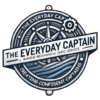If you’ve spent any significant time on the water, you know that marine diesel cooling issues are bound to arise sooner or later.
As a marine mechanic with over a decade of hands-on experience, I can confidently say that getting to know your marine diesel cooling system is one of the smartest things you can do. Not only will it help you understand what’s happening in your engine room, but it will also help you create a solid maintenance plan—keeping you on the water longer and reducing the chance of unexpected overheating problems.
Why Marine Diesel Engines Need Cooling
It doesn’t matter what size engine you have—all marine diesel engines require one or more cooling components.
Using seawater to cool a diesel engine is an ingenious and efficient method. While a car radiator uses air passing through fins to cool its internal coolant, a marine heat exchanger uses water-to-water cooling—cycling seawater through cooling tubes to absorb and carry away heat from the engine coolant.
This system keeps your engine within the correct operating temperature range, optimising performance and extending its life.
How the Marine Diesel Cooling System Works
A standard marine diesel cooling system operates like this:
- Seawater is drawn in through a through-hull fitting or your drive leg.
- A raw water pump (impeller-driven) draws in seawater.
- The seawater flows through various engine coolers—heat exchanger, aftercooler, oil cooler, fuel cooler.
- It then exits through the exhaust mixer, where it’s expelled with the exhaust gases.
This continuous flow of raw water cools your engine indirectly, reducing corrosion and heat stress on the engine block.

Why Indirect Cooling Is Better
By routing seawater through coolers rather than the engine block itself, you avoid exposing vital internal components to corrosive saltwater. This design drastically increases your engine’s service life.
If your engine begins to overheat, these coolers are the first components to inspect.
Heat Transfer: The Core of Cooling
Heat transfer occurs between two mediums. For example:
- Coolant removes heat from the hot engine block.
- Seawater removes heat from the coolant in the heat exchanger.
This chain of heat transfer maintains the engine’s optimal operating temperature, supporting efficient combustion and performance.
Closed Cooling Systems
A closed cooling system circulates engine coolant (often a water-glycol mix) through the engine in a sealed loop. Seawater cools the engine coolant via the heat exchanger, but never enters the engine itself.
Coolants
- Available in glycol-based (red or green) and non-glycol variants.
- Never mix different types or colors, as it can cause blockages or sludge buildup.
- Coolants provide corrosion resistance, thermal stability, and allow for higher horsepower and longer service life.
Raw Water System Overview
The raw water system draws seawater into the cooling circuit, where it:
- Enters the raw water pump
- Passes through engine coolers
- Exits via the exhaust mixer
This system harnesses the ocean’s natural cooling potential with simplicity and reliability.
Types of Marine Coolers
1. Heat Exchanger (Radiator)
- Transfers heat from engine coolant to seawater.
- Uses internal tubes to facilitate this process.
2. Fuel Cooler
- Seawater absorbs heat from high-pressure fuel, preventing vapor lock and ensuring efficiency.
3. Oil Cooler
- Similar to a fuel cooler but removes heat from engine oil to maintain lubrication effectiveness.
4. Aftercooler (Intercooler)
- Cools turbocharged air using seawater tubes and aluminum fins.
Cooler Construction Types
Shell and Tube
- Most common in marine diesel cooling systems.
- Seawater flows through tubes inside a shell; fluid to be cooled surrounds the tubes.
Plate Type Heat Exchanger
- Uses corrugated metal plates in alternating layers of coolant and seawater.
- Very efficient; often found on high-horsepower engines.
Tube and Fin
- Used in aftercoolers.
- Tubes carry seawater and fins cool passing air.
Other Key Cooling Components
Thermostats
- Open and close at set temps to regulate coolant flow.
- Ensure the engine reaches operating temp quickly and maintains it.
Exhaust Mixers (Turn-Downs)
- Where seawater and exhaust gases combine.
- Cools exhaust before it leaves the system.
Temperature Sensors
- Monitor coolant and exhaust temperatures.
- Trigger alarms, guardian modes, and provide engine data to the ECU and helm.
What Is a Safe Operating Temperature?
Most marine diesel engines operate at 80°C (176°F). Overheating usually begins around 95°C to 100°C.
Your specific engine’s operation manual will provide the ideal range. In general:
- Normal: 80°C – 92°C
- Warning: >95°C
- Danger: 100°C+
Can I Flush My Cooling System?
Yes—but the reason matters.
- Preventative flushing: Good maintenance practice; helps prevent buildup.
- Flushing due to overheating: Usually ineffective if blockages already exist. Manual cleaning may be required.
Cooler Maintenance Tips
- Run your engines regularly to prevent calcium buildup and corrosion.
- Add cooler flushing to your regular maintenance plan.
- Remember, coolers are serviceable components—they need to be removed, inspected, and cleaned periodically.
Conclusion: Mastering Your Marine Diesel Cooling System
As you can see, there’s more to marine diesel cooling than meets the eye. From raw water flow to heat exchanger construction, understanding your system helps you:
- Identify and prevent cooling issues.
- Maximise engine efficiency.
- Structure a long-term maintenance plan tailored to your vessel.
By getting familiar with your cooling system, you’re not only protecting your investment—you’re ensuring more time spent on the water, doing what you love.



